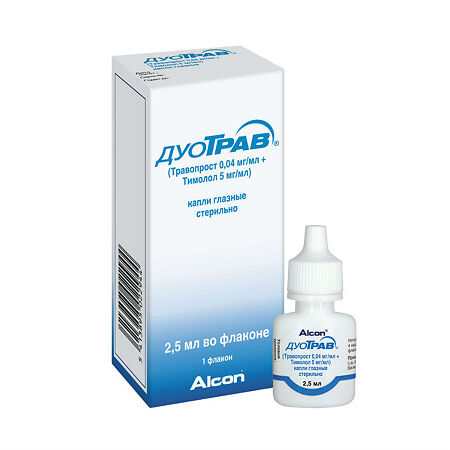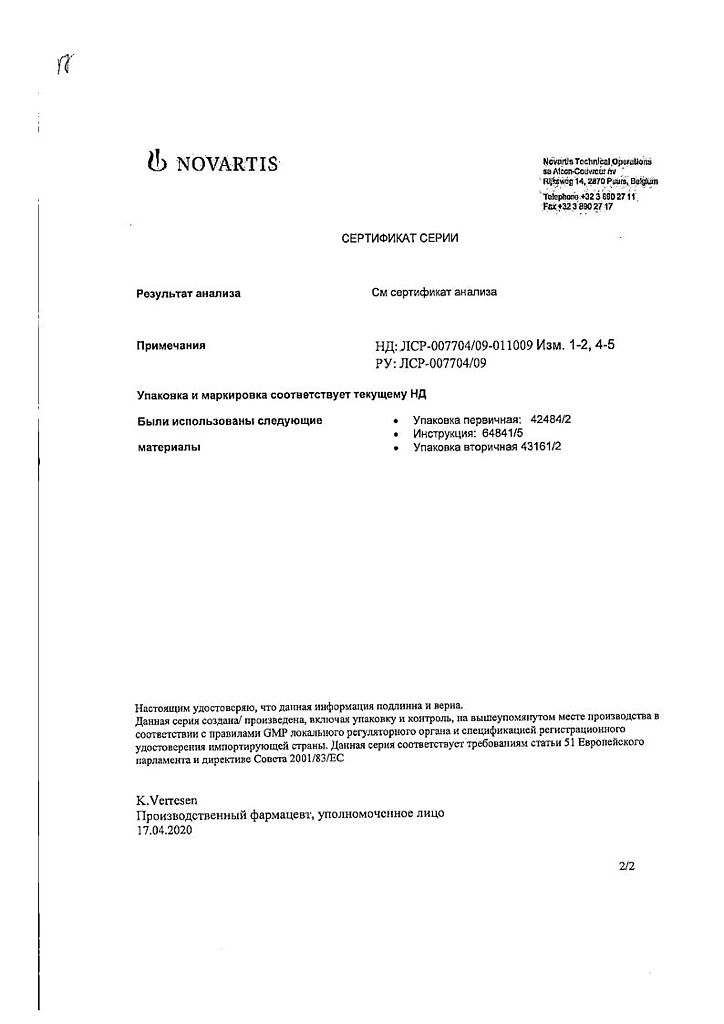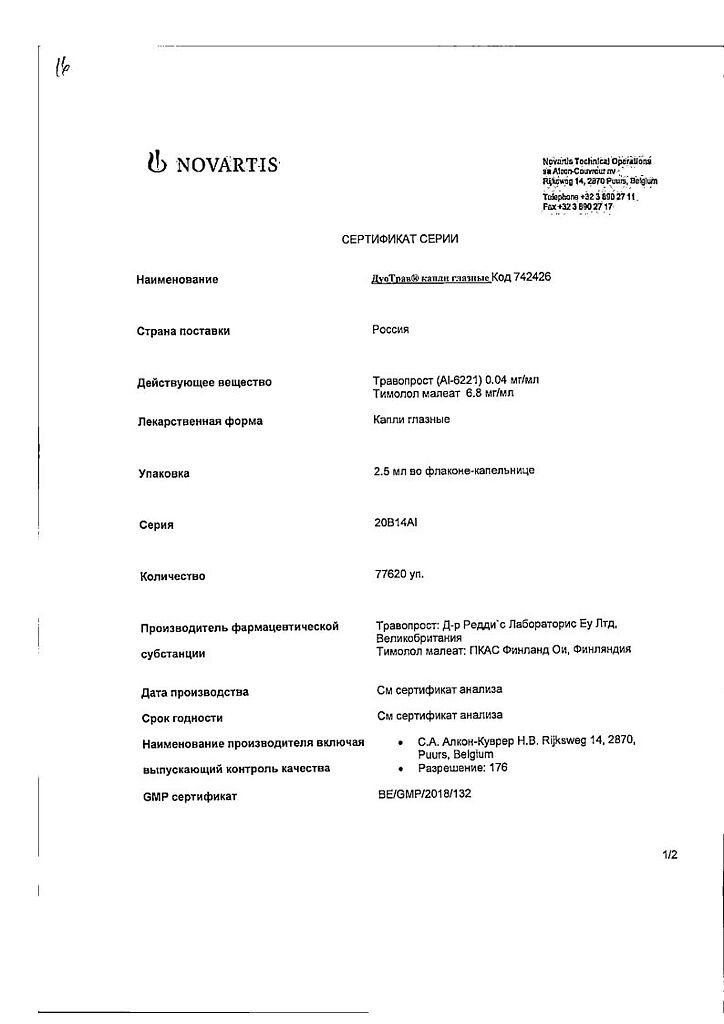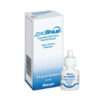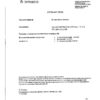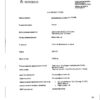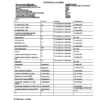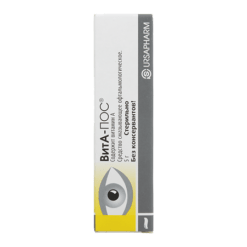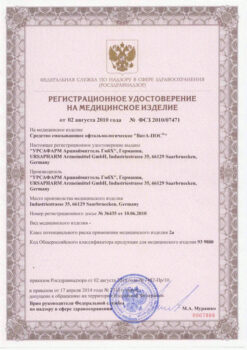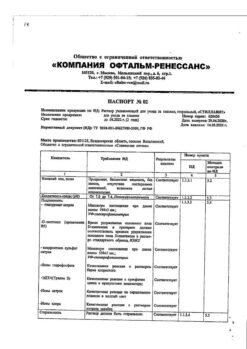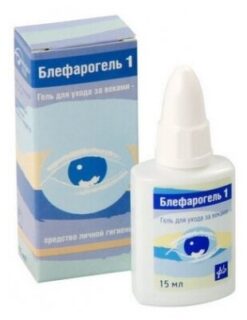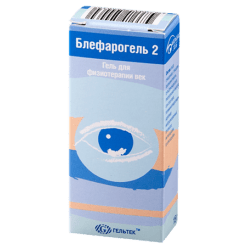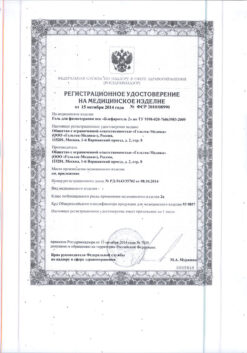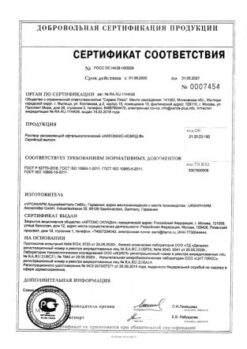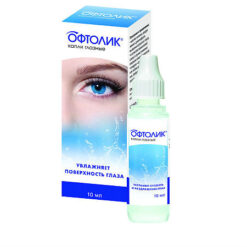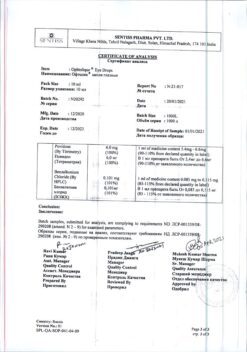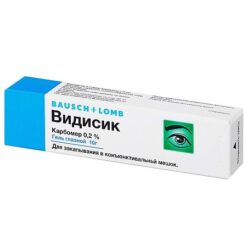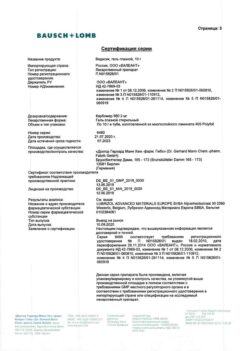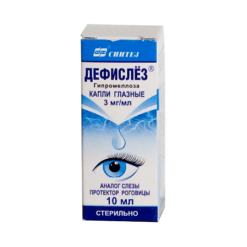No products in the cart.
DuoTrav, eye drops 2.5ml
€30.63 €25.53
Description
The properties of the drug are due to the action of its constituents travoprost and timolol.
Travoprost is a highly selective agonist of prostaglandin FP-receptors, is a synthetic analog of prostaglandin F2-alpha and is able to reduce intraocular pressure by improving aqueous outflow (increase uveoscleral outflow). It has no significant effect on aqueous humor production.
Timolol is a non-selective beta-adrenoreceptor blocker. It does not exhibit sympathomimetic activity, has no membrane stabilizing effect and has no depressant effect on the myocardium. When used topically, timolol reduces intraocular pressure by inhibiting the formation of aqueous humor, and slightly activates its outflow.
The decrease in intraocular pressure occurs approximately two hours after administration, with peak effect observed after 12 hours. A significant decrease in pressure is maintained for 24 hours after a single use of the drug.
Pharmacokinetics
Travoprost and timolol are absorbed through the cornea. In the cornea there is hydrolysis of travoprost to the biologically active form – acid travoprost.
Travoprost after topical administration is rapidly eliminated from plasma within one hour – plasma concentration decreases below the detection threshold – less than 0.01 ng/ml (can vary from 0.011 to 0.02 ng/ml). The plasma Cmax of timolol is 0.692 ng/ml and persists to the detection threshold for 12 h, and the Tmax of timolol is reached within one hour after topical administration. The T1/2 of timolol is 4 h after topical administration of DuoTrav. Travoprost is excreted as inactive metabolites mainly in the bile (61%). Free acid of travoprost and its metabolites are excreted by the kidneys. Less than 2% of hervoprost is detected in the urine as free acid.
Timolol and the resulting metabolites are excreted mainly by the kidneys. About 20% of timolol is excreted unchanged, the rest as metabolites.
Indications
Indications
Decreased intraocular pressure.
Therapy for open-angle glaucoma.
Pharmacological effect
Pharmacological effect
The properties of the drug are due to the action of its constituent components, travoprost and timolol.
Travoprost is a highly selective agonist of prostaglandin FP receptors, a synthetic analogue of prostaglandin F2-alpha, capable of reducing intraocular pressure by improving the outflow of aqueous humor (increasing uveoscleral outflow). It does not have a significant effect on the production of aqueous humor.
Timolol is a non-selective beta-adrenergic receptor blocker. It does not exhibit sympathomimetic activity, does not have a membrane-stabilizing effect and does not have an inhibitory effect on the myocardium. When applied topically, timolol reduces intraocular pressure, suppressing the formation of aqueous humor, and also slightly activates its outflow.
A decrease in intraocular pressure occurs approximately two hours after application, the peak effect is observed after 12 hours. With a single use of the drug, a significant decrease in blood pressure persists for 24 hours.
Pharmacokinetics
Travoprost and timolol are absorbed through the cornea of the eye. In the cornea, travoprost is hydrolyzed to its biologically active form – travoprost acid.
After topical application, Travoprost is rapidly cleared from the plasma within an hour – the concentration in the blood plasma decreases below the detection threshold – less than 0.01 ng/ml (can vary from 0.011 to 0.02 ng/ml). Cmax of timolol in blood plasma is 0.692 ng/ml and remains up to the detection threshold for 12 hours, and Tmax of timolol is achieved within an hour after topical application. T1/2 of timolol is 4 hours after topical application of DuoTrav. Travoprost is excreted as inactive metabolites, mainly in bile (61%). Travoprost free acid and its metabolites are excreted by the kidneys. Less than 2% of travoprost is found in urine as free acid.
Timolol and the resulting metabolites are excreted primarily by the kidneys. About 20% of timolol is excreted unchanged, the rest – in the form of metabolites.
Special instructions
Special instructions
Anaphylactic reactions
Patients with atopy or a history of severe anaphylactic reactions to various allergens receiving beta-blockers may be resistant to normal doses of epinephrine for the treatment of anaphylactic reactions.
Systemic effects
Travoprost and timolol may be subject to systemic absorption. Timolol, when used topically, can cause the same cardiovascular and respiratory side effects as systemic beta-blockers. The patient’s condition should be monitored before and during timolol therapy. Cases of severe respiratory and cardiovascular disorders have been described, including death from bronchospasm in patients with bronchial asthma and death from heart failure when using timolol.
Beta-blockers should be prescribed with caution to patients with a predisposition to hypoglycemia or diabetes (especially labile diabetes), since these drugs may mask the symptoms of acute hypoglycemia.
Beta blockers may mask the symptoms of hyperthyroidism and cause peripheral and central circulatory disorders and hypotension, as well as worsening Prinzmetal’s angina. Before a planned operation, beta-blockers should be gradually (not all at once!) withdrawn 48 hours before general anesthesia, because during general anesthesia, they can reduce the sensitivity of the myocardium to sympathetic stimulation necessary for cardiac function.
Local action
Travoprost may cause a gradual change in eye color by increasing the amount of brown pigment in melanocytes. Before starting treatment, patients should be informed about the possibility of changes in eye color. Treatment of only one eye can lead to permanent heterochromia.
The long-term effect on melanocytes and the consequences of this influence are currently unknown. Changes in iris color occur slowly and may go unnoticed for months or years. This effect is detected mainly in patients with mixed iris color, for example, blue-brown, gray-brown, green-brown or yellow-brown; however, it can also be observed in patients with brown eyes.
Typically, brown pigmentation extends concentrically around the pupil to the periphery of the iris, and the entire iris or parts of it may become a more intense brown color. After discontinuation of the drug, no further increase in the amount of brown pigment was observed, however, the color change that has already developed may be irreversible.
The drug may cause darkening, thickening and lengthening of eyelashes/or an increase in their number; rarely – darkening of the skin of the eyelids. The mechanism of these changes is currently unknown.
The drug contains the preservative benzalkonium chloride, which can be absorbed by contact lenses. Before using the drug, the lenses should be removed and put back no earlier than 15 minutes after using the drug. If, after using the drug, the patient’s vision clarity is temporarily reduced, until it is restored, it is not recommended to drive a car or engage in activities that require increased attention.
Do not touch the tip of the dropper bottle to any surface to avoid contamination of the dropper bottle and its contents. The bottle must be closed after each use.
Active ingredient
Active ingredient
Timolol, Travoprost
Composition
Composition
1 ml of solution contains:
Main active substances:
travoprost – 40 mcg;
timolol – 5 mg;
Auxiliary components:
benzalkonium chloride,
boric acid,
edetate disodium,
macrogol glyceryl hydroxystearate,
mannitol,
trometamol and/or hydrochloric acid,
purified water.
Pregnancy
Pregnancy
Contraindicated for pregnant women and during breastfeeding, children and adolescents under 18 years of age.
Contraindications
Contraindications
Hypersensitivity to components.
Bronchial asthma (and history), COPD, bronchial hyperreactivity.
Atrioventricular block, chronic heart failure (in the stage of decompensation), cardiogenic shock.
Severe allergic rhinitis.
Corneal dystrophy.
Individual intolerance to a group of beta-blockers.
Period of pregnancy, lactation.
Age up to 18 years.
DuoTrav is prescribed with caution when:
Neovascular, angle-closure, narrow-angle glaucoma, pigmentary or congenital glaucoma, open-angle glaucoma accompanied by pseudophakia, pseudoexfoliative glaucoma; ophthalmological inflammatory diseases; aphakia and pseudophakia with rupture of the posterior capsule of the lens, as well as patients with a likelihood of developing cystoid macular edema, uveitis or iritis.
Beta-blockers are also prescribed with caution to patients with diabetes mellitus or a tendency to hypoglycemia, since these drugs mask the symptoms of acute hypoglycemia.
In addition, they can mask the signs of hyperthyroidism and provoke central and peripheral circulatory disorders and hypotension. Beta-blockers are canceled (gradually!) before planned surgical interventions, because together with general anesthesia, they can reduce the sensitivity of the myocardium to sympathetic stimulation, which is necessary for cardiac activity.
Side Effects
Side Effects
Local effects:
Conjunctival hyperemia, eye irritation. Pinpoint keratitis, effusions in the anterior ocular chamber, pain and itching at the site of application, photophobia, conjunctival hemorrhages, discomfort in the eye, corneal erosion, decreased visual acuity, sensation of a veil before the eyes, blurred vision, dry eyes, allergic conjunctivitis, increased lacrimation, eyelid erythema, eyelid irritation, eyelid dermatitis, periorbital skin hyperpigmentation, asthenopia, changes in eyelash color and length, blepharitis, allergic reactions.
Systemic effects:
General anxiety, headache, dizziness, increased or decreased blood pressure, arrhythmia, bradycardia, bronchospasm, urticaria, joint pain.
Shortness of breath, laryngeal irritation, cough, increased levels of alanine aminotransferase or aspartate aminotransferase, contact dermatitis, thirst, change in urine color, postnasal drip syndrome. Corneal damage, chest pain, tachycardia.
Interaction
Interaction
No interaction studies have been conducted with other drugs.
There is a possibility of increased hypotensive effect and/or the development of severe bradycardia with simultaneous use of timolol with calcium channel blockers for oral administration, guanethidine, beta-blockers, antiarrhythmic drugs, cardiac glycosides and parasympathomimetics.
The development of hypertension after abrupt withdrawal of clonidine may be exacerbated by concomitant use of beta-blockers.
Beta-blockers may enhance the hypoglycemic effect of antidiabetic agents. Beta blockers may mask the symptoms of hypoglycemia.
DuoTrav can be used in combination with other topical ophthalmic medications to reduce intraocular pressure.
In this case, the interval between their use should be at least 5 minutes. The simultaneous use of two local beta-blockers or two local prostaglandin analogues is not recommended.
Overdose
Overdose
Symptoms: irritation of the mucous membrane of the eye, hyperemia of the conjunctiva or episclera, bradycardia, decreased blood pressure, bronchospasm and cardiac arrest.
Treatment: immediate rinsing of the groove with water and symptomatic therapy are recommended. Hemodialysis is ineffective.
Storage conditions
Storage conditions
At 2–25 °C
Shelf life
Shelf life
3 years
Manufacturer
Manufacturer
Alcon-Couvreur, Belgium
Additional information
| Shelf life | 3 years |
|---|---|
| Conditions of storage | At 2-25 °C |
| Manufacturer | Alcon-Couvreur, Belgium |
| Medication form | eye drops |
| Brand | Alcon-Couvreur |
Related products
Buy DuoTrav, eye drops 2.5ml with delivery to USA, UK, Europe and over 120 other countries.

